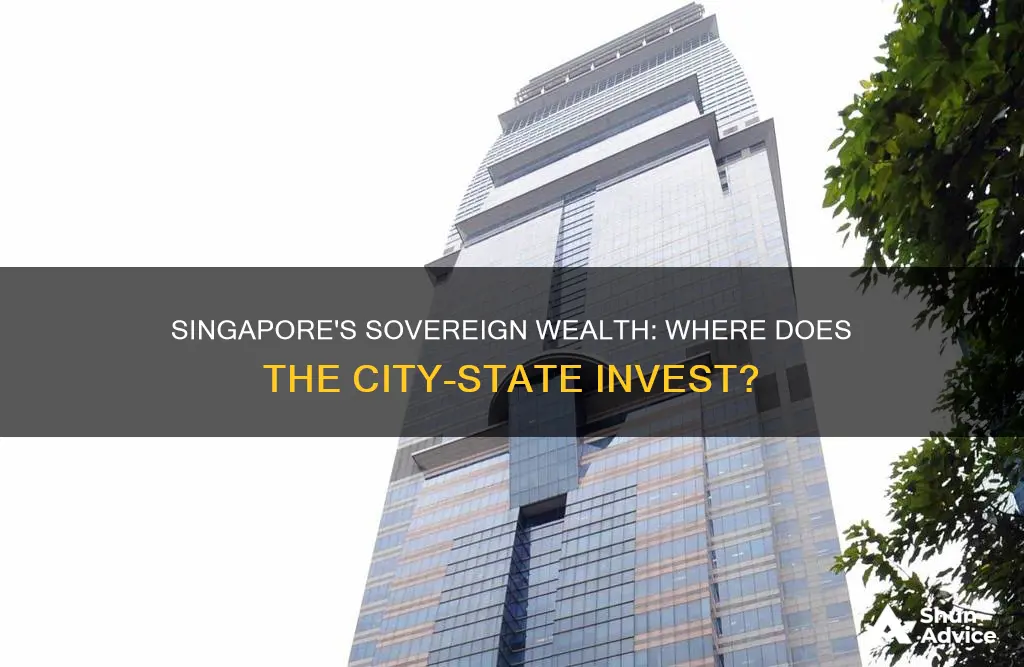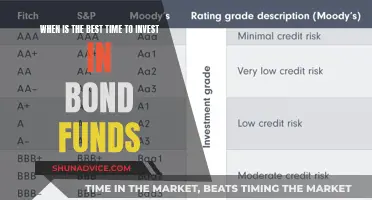
Singapore has two of the oldest and largest sovereign wealth funds in the world, the Government Investment Corporation (GIC) and Temasek Holdings (TSK). GIC was established in 1981 to manage Singapore's foreign reserves and is owned by the Singapore government. It has a presence in over 40 countries and its investments include developed market equities, emerging market equities, bonds, private equity and real estate. Temasek Holdings operates like an equity investment firm with significant independence from the government. Both funds have contributed to Singapore's reserves, which serve as a buffer for downturns, enhance the resilience of the Singapore dollar, and provide income for the government's annual budget.
| Characteristics | Values |
|---|---|
| Number of Sovereign Wealth Funds | 2 |
| Names of Sovereign Wealth Funds | Temasek Holdings (TSK) and the Government Investment Corporation (GIC) |
| Type of Sovereign Wealth Fund | TSK operates like an equity investment firm; GIC operates like an asset management company |
| Investment Strategy | GIC invests in a full spectrum of financial assets, including sovereign debt and infrastructure |
| Geographical Diversification | GIC is invested in more than 40 countries worldwide |
| Asset Allocation | 34% in the US, 3% in Latin America, 6% in the rest of the Americas, 6% in the UK, 12% in the Eurozone, 6% in the Middle East, Africa and the rest of Europe, 19% in Asia excluding Japan, 12% in Japan and 2% in Australasia |
| Investment Performance | For the year ended 31 March 2017, GIC's annualised 20-year real rate of return was 3.7%. In USD nominal terms, GIC achieved an annualised return of 5.1%, 4.3%, and 5.7% for the 5-year, 10-year, and 20-year time periods, respectively |
| Assets Under Management | GIC: US$744 billion (Forbes estimate as of September 2023); TSK: US$630 billion |
What You'll Learn

Singapore's two sovereign wealth funds
Singapore has two sovereign wealth funds: Temasek Holdings (TSK) and the Government Investment Corporation (GIC). Both funds are among the oldest and largest sovereign wealth funds globally, reflecting Singapore's strong macroeconomic fundamentals and fiscal discipline. Here is a detailed overview of each fund:
Temasek Holdings (TSK)
Temasek Holdings operates as an equity investment firm with significant independence from the government in its day-to-day operations and a relatively high degree of transparency. As of 2022, Temasek Holdings managed approximately $630 billion in assets. Temasek has suffered losses due to China's crackdown on the online education space and has a stake in Ant Group Co., a fintech giant that faced challenges with its listing due to regulatory scrutiny. Temasek also has a 2050 net-zero goal, which may impact its investment strategies in certain countries.
Government Investment Corporation (GIC)
The Government Investment Corporation (GIC), established in 1981, manages Singapore's foreign reserves with the mandate to preserve and enhance the country's international purchasing power over the long term. GIC operates like an asset management company, under tight control by the government, and its investments are not fully disclosed to the public. GIC has a global presence with investments in over 40 countries. As of 2017, its portfolio breakdown by region included 34% in the US, 19% in Asia (excluding Japan), 12% in the Eurozone, 12% in Japan, 6% in the UK, 6% in the Middle East/Africa/rest of Europe, 6% in Latin America, 3% in the rest of the Americas, and 2% in Australasia. GIC's total assets under management were estimated at US$744 billion as of 2022 and could reach nearly US$900 billion with new legislation, making it one of the largest sovereign wealth funds globally. GIC's investments span various sectors, including technology, real estate, private equity, and sustainable energy.
IRA and Mutual Funds: A Smart Investment Strategy
You may want to see also

GIC's investment portfolio
GIC Private Limited is a Singaporean sovereign wealth fund that manages the country's foreign reserves. Established in 1981, its mission is to preserve and enhance the international purchasing power of the reserves, with the aim to achieve good long-term returns above global inflation over a 20-year investment horizon.
GIC has a broad investment mandate and the ability to invest across a full spectrum of financial assets, from sovereign debt to infrastructure. It manages approximately 80% of its portfolio in-house and has a network of 10 offices in key financial capitals worldwide.
GIC's portfolio is diversified and resilient, spanning six core asset classes: Developed Market Equities, Emerging Market Equities, Nominal Bonds and Cash, Inflation-Linked Bonds, Private Equity, and Real Estate. This diversification enables the portfolio to generate good risk-adjusted returns over the long term. GIC's investment strategy is to build a portfolio comprising asset classes that can generate good long-term returns above global inflation while adhering to the client's risk parameters.
GIC does not disclose the amount of funds it manages or its annual profit and loss. However, as of September 2023, the Sovereign Wealth Fund Institute (SWFI) estimated the fund's assets at US$770 billion, while Forbes estimated it at US$744 billion. GIC's annualised rate of return over a 20-year period ending 31 March 2024 was 3.9% above global inflation.
Mutual Funds: A Smart Investment Choice for Beginners
You may want to see also

Temasek Holdings
Temasek's portfolio covers a broad spectrum of sectors, with key focus investment areas including Consumer, Media & Technology, Life Sciences & Agri-Food, and Non-Bank Financial Services. The company's portfolio is anchored in Asia, with a global outlook and a 64% underlying exposure to developed economies. Temasek's one-year total shareholder return (TSR) was 1.60%, with longer-term 10-year and 20-year TSRs at 6% and 7% respectively, compounded annually. Its TSR since inception was 14%, compounded over 50 years.
Temasek has four key structural trends that guide its long-term portfolio construction: Digitisation, Sustainable Living, Future of Consumption, and Longer Lifespans. The company deploys capital to catalyse solutions and enable companies to transition to a more sustainable future, tapping into future growth sectors and business models. Temasek's investment activities are aligned with these four structural trends, and the company invests in businesses that directly enable, drive, and benefit from these trends.
Temasek's unlisted portfolio has grown steadily over the years, with investments in attractive opportunities in private markets and increased value of unlisted assets. As of 31 March 2023, 47% of Temasek's portfolio was in liquid and listed assets, while 53% was in unlisted assets and funds. The company's unlisted portfolio is well-diversified geographically and sector-wise, with unlisted Singapore companies constituting over a third of the unlisted portfolio. Temasek's asset management businesses manage around S$79 billion in assets, including third-party capital and their own capital.
Temasek has made notable investments in recent years, including:
- A 3.9% stake in BlackRock Inc. in August 2020, worth about US$3.5 billion.
- Leading a €140 million series C financing of French biotechnology company InnovaFeed in November 2020, in collaboration with Creadev.
- Investing in cryptocurrency exchange FTX in 2021.
- Leading a $200 million fundraising round for Singaporean cryptocurrency financing company, Amber Group, in February 2022.
- Finalising talks to lead a $50 million financing round for Indian startup DotPe in May 2022.
- Leading a $108 million financing round for Indian startup Country Delight in 2022, in collaboration with Ventury Partners.
- Leading a $100 million financing round for Animoca Brands in August 2022.
- Acquiring an additional 41% stake in Manipal Health Enterprises in April 2023, resulting in a total stake of 59%.
- Finalising the sale of some assets from liquefied natural gas (LNG) trading company Pavilion Energy to Shell in June 2024, in a deal worth hundreds of millions of US dollars.
Retirement Planning: Beyond the 401(k) and Emergency Fund
You may want to see also

Monetary Authority of Singapore
The Monetary Authority of Singapore (MAS) is the country's central bank and monetary authority. In 2023, Forbes estimated the MAS's assets to be US$478 billion.
In 1981, then-First Deputy Prime Minister and MAS Chairman, Goh Keng Swee, noticed Singapore's rapidly growing foreign reserves and decided to invest the reserves for the country's future and the welfare of its people. This led to the establishment of the Government of Singapore Investment Corporation (GIC), which manages Singapore's foreign reserves.
The GIC is a global long-term investor with a presence in over 40 countries worldwide. It has a mandate to preserve and enhance Singapore's international purchasing power over the long term. The GIC's funds are owned by the Singapore government, and its investment returns supplement the country's annual budget in areas such as education, R&D, healthcare, and infrastructure.
The GIC has a diversified investment portfolio, investing in a range of financial assets, including sovereign debt, infrastructure, developed market equities, emerging market equities, nominal bonds, inflation-linked bonds, private equity, and real estate. As of 2017, the GIC held around 34% of its portfolio in the US, 12% in the Eurozone, 19% in Asia (excluding Japan), and 12% in Japan, among other regions.
The GIC does not disclose the exact amount of funds it manages or its annual profit and loss to prevent speculation against the Singapore dollar during vulnerable periods. However, various sources have provided estimates of the GIC's assets under management.
Mutual Funds: Where Are Your Investments Going?
You may want to see also

Singapore's foreign reserves
GIC's mission is to preserve and enhance Singapore's international purchasing power, aiming for long-term returns above global inflation. The fund's performance is measured by its overall portfolio rather than individual investments, with a focus on maintaining a well-diversified portfolio to manage risk. As of September 2023, the Sovereign Wealth Fund Institute estimated GIC's assets at US$770 billion, while Forbes estimated US$744 billion after a transfer of about US$137 billion from MAS.
In addition to GIC, Temasek Holdings is another significant sovereign wealth fund in Singapore, with about US$630 billion in assets under management. The country's national pension plan, the Central Provident Fund (CPF), also holds US$397 billion in assets. The MAS, Singapore's central bank and monetary authority, holds US$478 billion.
The income generated from investing Singapore's foreign reserves supplements the government's annual budget, allowing for further investments in areas such as education, R&D, healthcare, and infrastructure. This income, known as the Net Investment Returns Contribution (NIRC), is estimated to be S$23.5 billion for the 2024 Financial Year.
GIC's investment strategy includes a disciplined approach to long-term value investing, with a focus on technology and sustainable investments. The fund has a global presence, with 10 offices in key financial capitals worldwide. GIC's investments span various regions, with a significant portion of its portfolio in the US, Asia, and Europe.
Overall, Singapore's foreign reserves are carefully managed by GIC, Temasek, and MAS, with a focus on long-term value creation and risk management. The income generated from these investments contributes significantly to the country's economic development and the welfare of its citizens.
Mid-Cap Funds: Smart Investment Timing for Optimal Returns
You may want to see also
Frequently asked questions
Sovereign wealth funds (SWF) are state-owned investment funds that invest in real and financial assets such as stocks, bonds, real estate, precious metals, or alternative investments like private equity funds or hedge funds. They invest globally and are funded by revenues from commodity exports or foreign-exchange reserves held by the central bank.
Singapore has two of the oldest and largest sovereign wealth funds: Temasek Holdings (TSK) and the Government Investment Corporation (GIC).
TSK operates like an equity investment firm with significant independence in its day-to-day operations from the government and a relatively high degree of transparency. GIC, on the other hand, operates like an asset management company, under tight government control, and with lower transparency.
The funds enable Singapore to manage its reserves for long-term returns, preserving and enhancing the country's international purchasing power. They also serve as a buffer during economic downturns, foster investor confidence, and provide income for the government's annual budget.
GIC, established in 1981, invests in more than 40 countries worldwide. As of 2017, its portfolio breakdown by geography was as follows: 34% in the US, 3% in Latin America, 6% in the rest of the Americas, 6% in the UK, 12% in the Eurozone, 6% in the Middle East, Africa, and the rest of Europe, 19% in Asia excluding Japan, 12% in Japan, and 2% in Australasia. GIC's specific investments include a stake in British specialist bank OakNorth, Dapper Labs, and UK specialist insurance and reinsurance broker Miller.







